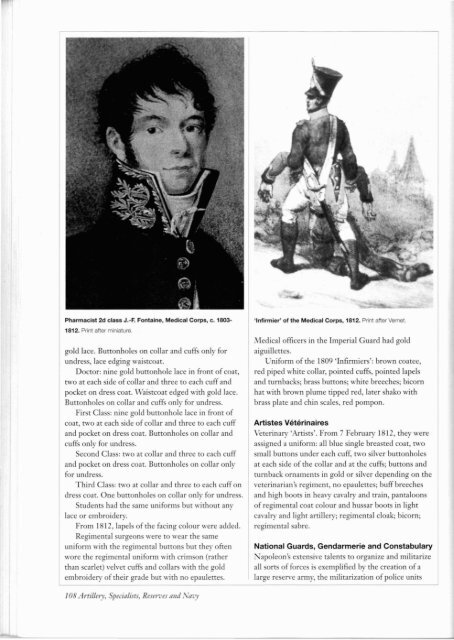Create successful ePaper yourself
Turn your PDF publications into a flip-book with our unique Google optimized e-Paper software.
Pharmacist2d class J.-F. Fontaine, Medical Corps, c. 18031812. Print after miniature.gold lace. Bunonholes on collar and cuffs only forundress, lace edging waistcoat.Doctor: nine gold buttonhole lace in front of coat,two at each side ofcollar and three to each cuff andpocket on dress coat. Waistcoat edged with gold lace.Buttonholes on collar and cuffs only for undress.First Class: nine gold bunonhole lace in front ofcoat, two at each side of collar and three to each cuffand pocket on dress coat. Buttonholes on collar andcuffs only for undress.Second Class: two at collar and three to each cuffand pocket on dress coat. Buttonhole on collar onlyfor undress.Third Class: two at collar and three to each cuffondre s coat. One buttonholes on collar only for undress.Students had the same uniforms but without anylace or embroidery.From 1812, lapels of the facing colour were added.Regimental surgeons were to wear the sameuniform with the regimental bunons but they oftenwore the regimental uniform with crimson (ratherthan scarlet) veket cuffs and collar with the goldembroidery of their grade but with no epaulenes.'Infirmier' of the Medical Corps, 1812. Print after Vernel."Iedical officers in the Imperial Guard had goldaiguillenes.niform of the 1809 'Infirmiers': brown coatee,red piped white collar, pointed cuffs, pointed lapelsand turnbacks; brass buttons; white breeches; bicornhat with brown plume tipped red, later shako withbrass plate and chin scales, red pompon.Artistes VeterinairesVeterinary 'Artists'. From 7 February 1812, they wereassigned a uniform: all blue single breasted coat, twosmall buttons under each cuff, two silver buttonholesat each side of the collar and at the cuffs; buttons andturnback ornaments in gold or silver depending on theveterinarian's regiment, no epaulenes; buff breechesand high boots in heavy cavalry and train, pantaloonsof regimental coat colour and hussar boots in lightcavalry and light artillery; regimental cloak; bicorn;regimental sabre.National Guards, Gendarmerie and Constabulary<strong>Napoleon's</strong> extensive talents to organize and militarizeall sorts of forces is exemplified by the creation ofalarge re en'e army, the militarization of police unitsNational Guard levies of 1814 in battle wearing the blue smock.Pnnt after Raffel.and the creation or transformation of ci,-il sen-iceunits into con tabulary' and para-military corps.Garde NationaleN"ational Guards. In 1789, l'\ational Guard unitssprang up all over France replacing the militia and, tosome extent, constabulary· forces. "Iany were com'eftedinto active units or faded away during the 1790s sothat when Tapoleon came to power, the institutionwas all but nonexistent as an effective force. In 1805,the National Guard was completely restructured andorganized in battalion-like cohorts (ten companieseach including grenadiers and chasseurs), They wereto assist in the maintenance of interior order, providegarrisons in forts and patrol the frontiers. In 1806, 31legions each having four cohorts were mobilized;1807, five 'Legions de resen'e de I'interieur' wereformed for active duty, each having six cohofts and anartillery company; cohorts reorganized into eightNational Guard infantry private, 1807. The uniform was similarto the line infantry except for white metal buttons. Pnm afterMarti<strong>net</strong>.JJ08 Al"tillelY, Specialists, Reserves alld 1 avypecialists, ReSI?I1JeS alldavy J09










